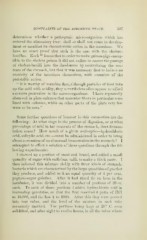Page 335 - My FlipBook
P. 335
:
COMPLAINTS OF THE DIGESTIVE TRACT. 307
determines whether a pathogenic micro-organism which has
entered the alimentary tract shall or shall not come to develop-
metit or manifest its characteristic action in the intestines. "We
have an exact proof that such is the case with the cholera-
bacillus. Koch -*'' found that in order to make guinea-pigs suscep-
tible to the cholera poison it did not suffice to secure the passage
of cholera-bacilli into the duodenum by neutralizing the con-
tents of the stomach, but that it was necessary first to induce an
atonicity of the intestines themselves, with cessation of the
peristaltic action.
" It is worthy of mention that, although particles of food take
up the acid with avidity, they nevertheless often appear to afford
a certain protection to the micro-organisms. I have repeatedly
observed in plate-cultures that muscular fibers in particular were
lined with colonies, while on other parts of the plate very few
were to be seen."
Some further questions of interest in this connection are the
following : At what stage in the process of digestion, or at what
percentage of acid in the contents of the stomach, does fermen-
tation cease ? How much of a given antiseptic—hydrochloric
acid, salicylic acid, etc.—must be administered in order to bring
about a cessation of an abnormal fermentation in the stomach ? I
attempted to effect a solution of these questions through the fol-
lowing experiments
I chewed up a portion of meat and bread, and added a small
quantity of sugar with sufficient milk to make a thick paste. I
then infected this mixture richly with three kinds of stomach-
bacteria which are characterized by the large quantities of gas that
they produce, and added to it an equal quantity of 4 per cent,
peptone-sagar gelatine. After it had stood for an hour in the
incubator, it was divided into a number of portions of 20 ec.
each. To each of these portions I added hydrochloric acid in
increasing quantities, so that the first received 4 parts of IICl
to 10,000, and the last 2 to 1000. After this they were poured
into test tubes, and the level of the mixture in each tube
accurately marked. The portions being kept at 20° C. soon
solidified, and after eight to twelve hours, in all the tubes where
COMPLAINTS OF THE DIGESTIVE TRACT. 307
determines whether a pathogenic micro-organism which has
entered the alimentary tract shall or shall not come to develop-
metit or manifest its characteristic action in the intestines. "We
have an exact proof that such is the case with the cholera-
bacillus. Koch -*'' found that in order to make guinea-pigs suscep-
tible to the cholera poison it did not suffice to secure the passage
of cholera-bacilli into the duodenum by neutralizing the con-
tents of the stomach, but that it was necessary first to induce an
atonicity of the intestines themselves, with cessation of the
peristaltic action.
" It is worthy of mention that, although particles of food take
up the acid with avidity, they nevertheless often appear to afford
a certain protection to the micro-organisms. I have repeatedly
observed in plate-cultures that muscular fibers in particular were
lined with colonies, while on other parts of the plate very few
were to be seen."
Some further questions of interest in this connection are the
following : At what stage in the process of digestion, or at what
percentage of acid in the contents of the stomach, does fermen-
tation cease ? How much of a given antiseptic—hydrochloric
acid, salicylic acid, etc.—must be administered in order to bring
about a cessation of an abnormal fermentation in the stomach ? I
attempted to effect a solution of these questions through the fol-
lowing experiments
I chewed up a portion of meat and bread, and added a small
quantity of sugar with sufficient milk to make a thick paste. I
then infected this mixture richly with three kinds of stomach-
bacteria which are characterized by the large quantities of gas that
they produce, and added to it an equal quantity of 4 per cent,
peptone-sagar gelatine. After it had stood for an hour in the
incubator, it was divided into a number of portions of 20 ec.
each. To each of these portions I added hydrochloric acid in
increasing quantities, so that the first received 4 parts of IICl
to 10,000, and the last 2 to 1000. After this they were poured
into test tubes, and the level of the mixture in each tube
accurately marked. The portions being kept at 20° C. soon
solidified, and after eight to twelve hours, in all the tubes where


